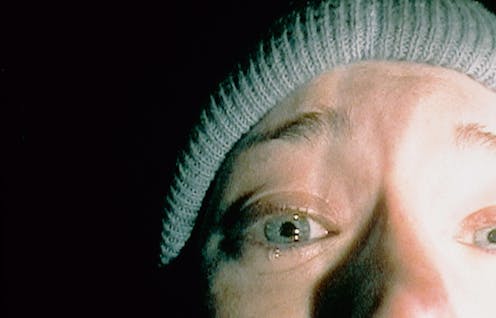how one film changed the horror genre as we know it
- Written by Adam Daniel, Associate Lecturer in Communications, Western Sydney University

This year marks the 25th anniversary of The Blair Witch Project, a film that popularised the found-footage horror sub-genre and captivated a generation of horror fans.
Made on a shoestring budget of less than US$60,000 by writer/director team Daniel Myrick and Eduardo Sanchez, the film went on to gross US$248 million internationally, becoming one of the most successful films of all time by return on investment.
It also inspired a generation of indie filmmakers to overcome the limitations of low-budget filmmaking by leaning into the explicit presence of a camera within the story, such as with the Paranormal Activity series (2007–15), Creep (2014) and Hell House LLC (2015). In more recent tributes to the genre, such as the 2023 film Missing, older-style cameras are replaced with phone and laptop cameras.
Between reality and fiction
The Blair Witch Project famously opens with the following title card:
In October of 1994, three student filmmakers disappeared in the woods near Burkittsville, Maryland while shooting a documentary called ‘The Blair Witch Project’. A year later their footage was found.
This introduction – and the promotion of the film as a record of true events – was part of a successful viral marketing strategy that leveraged the burgeoning internet culture of the time.
This strategy included a website which presented further details about the disturbing legend of the Blair Witch and the police investigation into the disappearance of students Heather, Mike and Josh.
Combined with the buzz from a successful Sundance debut in January 1999, the mythology surrounding the film intrigued audiences. And some viewers considered the possibility what they were watching was a genuine set of recordings – and not just fiction.
This conceit of blurring the line between fiction and reality had already been established in cult horror movies such as Ruggero Deodato’s 1980 film Cannibal Holocaust. But it was The Blair Witch Project that catapulted found-footage horror into the broader public consciousness.
The rise of reality TV in the 2000s meant viewers were increasingly being presented with documentary-style images which were claimed to be authentic (despite their constructed nature). In my book on found-footage horror, I argue the growing presence of screens and cameras in everyday life also contributed to the sub-genre’s popularity.
Found-footage scholar Alexandra Heller-Nicholas describes the experience of watching found-footage horror as an invitation to “indulge in an active horror fantasy”. Part of the appeal, she says, emerges from “something we rationally know not to be true (the supernatural)” being temporarily accepted as true because of our trust in the documentary-style aesthetic.
But of course, this temporary acceptance is underpinned by the knowledge the events are not real.
The future of Blair Witch
Since the early 2000s, there has been a marked decrease in the power of such “active horror fantasy” at the cinema. This is no doubt related to the public’s increasing scepticism of the visual image.
Speaking to The New York Times, The Blair Witch Project creators Myrick and Sanchez acknowledge that part of the success of the film was that it was a product of a unique window of time (before the media identified it as fiction). In 2016, a sequel to the two original Blair Witch films was met with a middling critical and audience response, seemingly confirming their beliefs.
This year, film studios Lionsgate and Blumhouse touted plans for a new sequel to The Blair Witch Project, although the original filmmaking team and cast were reportedly not approached for input. Upon hearing the news, the cast shared an open letter calling for retroactive compensation and meaningful consultation on the new film.
On a recent podcast, Sanchez shared his hopes for both a prequel set in the 1700s and a potential TV series that picks up where the original film ended.
New generations of film makers
While the presence of found-footage horror at the cinema may have declined in recent decades, the internet and streaming have provided a location for those inspired by The Blair Witch Project to continue to draw on the film’s aesthetics and storytelling devices.
Running from 2009 to 2014, the web series Marble Hornets adapted the Slenderman mythology as a found-footage exploration of a mysterious entity haunting the lives and cameras of a group of college students.
More recently, YouTuber Kane Parsons created a viral sensation by adapting a creepypasta known as The Backrooms into a series of YouTube short films. The viral success of these led to Parson’s recruitment to adapt the story into a feature film for studio A24.
The inventive 2022 series Archive 81 also became a critical success on Netflix, but was unfortunately cancelled after one season.
Horror as a genre will always find a way to infiltrate the media we consume. While it may seem unlikely any modern found-footage horror could captivate an audience the way The Blair Witch Project did, it’s only a matter of time before the next generation of storytellers create a terrifying new monster to haunt us.
Authors: Adam Daniel, Associate Lecturer in Communications, Western Sydney University





